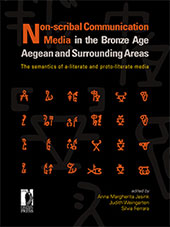Non-scribal communication media in the Bronze Age Aegean and surrounding areas : the semantics of a-literate and proto-literate media (seals, potmarks, mason's marks, seal-impressed pottery, ideograms and logograms, and related systems)
viii, 256 p.
This volume is intended to be the first in a series that will focus on the origin of script and the boundaries of non-scribal communication media in proto-literate and literate societies of the ancient Aegean. Over the last 30 years, the domain of scribes and bureaucrats has become much better known. Our goal now is to reach below the élite and scribal levels to interface with non-scribal operations conducted by people of the 'middling' sort. Who made these marks and to what purpose? Did they serve private or (semi-) official roles in Bronze Age Aegean society? The comparative study of such practices in the contemporary East (Cyprus, Anatolia, the Levant, and Egypt) can shed light on sub-elite activities in the Aegean and also provide evidence for cultural and economic exchange networks. Anna Margherita Jasink is Professor of Aegean Civilizations at the University of Florence. Her research interests are focused on historical and philological problems of the Aegean and Near Eastern worlds.
Her many publications include Cilicia. Dall'età di Kizzuwatna alla conquista macedone (with Desideri), Gli stati neoittiti. Analisi delle fonti scritte e sintesi storica, Cretan Hieroglyphic Seals: a new classification of symbols and ornamental/filling motifs and Minoan Cushion Seals: Innovations in Form, Style, and Use in Bronze Age Glyptic( with J. Weingarten and G. Dionisio). She is chief editor of the Periploi series and directs two web portals: the interactive museum MUSINT (aegean-museum.it) and the Aegean Laboratory (dbas.sciant.unifi.it). Judith Weingarten, M.Litt. (Oxford), is author of numerous articles and monographs on Minoan-Mycenaean glyptic art, its implications for social, economic, and political relationships, and cultural interactions between the Aegean and East Mediterranean and Egypt. Books include The Zakro Master and his Place in Prehistory,The Transformation of Egyptian Taweret into the Minoan Genius, and Minoan Cushion Seals: Innovations in Form, Style, and Use in Bronze Age Glyptic.
Silvia Ferrara is Associate Professor of Aegean Civilizations at Sapienza, University of Rome. She is interested in the phenomenon of writing, its invention and development, and its interface between art, language, material culture, visual perception and cognitive mechanisms. She has written widely on ancient writing systems, in particular two books on the Cypro-Minoan script, published by Oxford University Press: Cypro-Minoan Inscriptions. Volume 1: Analysis (2012) and Cypro-Minoan Inscriptions. Volume 2: The Corpus (2013), and several articles on the alphabet, Cretan Hieroglyphic, Linear B, Ugaritic cuneiform, and the theoretical modelling of ancient script formation. [Publisher's text].
Includes bibliographical references.
-
Información
ISBN: 9788864536378
MATERIAS



